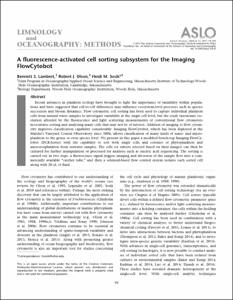A fluorescence-activated cell sorting subsystem for the Imaging FlowCytobot.

View/
Average rating
votes
Date
2017Author
Lambert, Bennett S.
Olson, Robert J.
Sosik, Heidi M.
Metadata
Show full item recordAbstract
Recent advances in plankton ecology have brought to light the importance of variability within populations and have suggested that cell-to-cell differences may influence ecosystem-level processes such as species succession and bloom dynamics. Flow cytometric cell sorting has been used to capture individual plankton cells from natural water samples to investigate variability at the single cell level, but the crude taxonomic resolution afforded by the fluorescence and light scattering measurements of conventional flow cytometers necessitates sorting and analyzing many cells that may not be of interest. Addition of imaging to flow cytometry improves classification capability considerably: Imaging FlowCytobot, which has been deployed at the Martha's Vineyard Coastal Observatory since 2006, allows classification of many kinds of nano- and microplankton to the genus or even species level. We present in this paper a modified bench-top Imaging FlowCytobot (IFCB-Sorter) with the capability to s.....
Journal
Limnology and Oceanography: MethodsVolume
15Page Range
pp.94-102Document Language
enSustainable Development Goals (SDG)
14.aEssential Ocean Variables (EOV)
Zooplankton biomass and diversityDOI Original
https://doi.org/10.1002/lom3.10145Citation
Lambert, B.S., Olson, R.J. and Sosik, H.M. (2017) A fluorescence-activated cell sorting subsystem for the Imaging FlowCytobot. Limnology and Oceanography: Methods, 15: pp.94-102. DOI: https://doi.org/10.1002/lom3.10145Collections
The following license files are associated with this item:
 Repository of community practices in Ocean Research, Applications and Data/Information Management
Repository of community practices in Ocean Research, Applications and Data/Information Management
